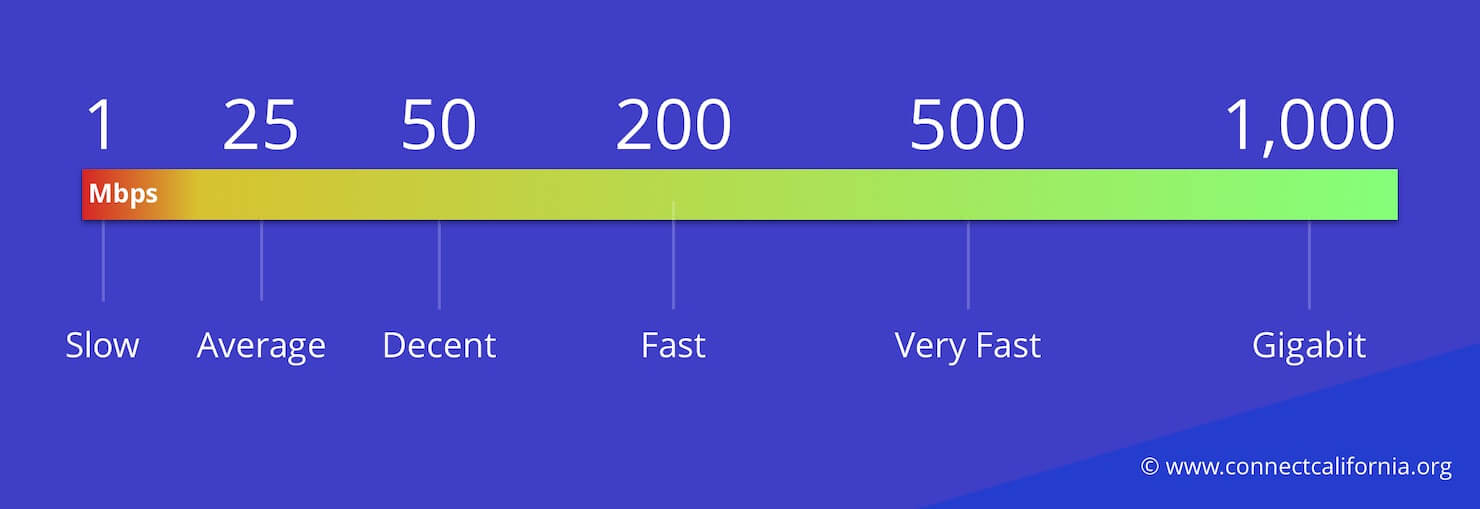In this guide, we’ll explain the factors that matter when setting up your internet for gaming in simple, beginner-friendly terms.
In short: speed matters, but not as much as latency does.
The best internet connections for gaming are wired internet services like fiber and cable. DSL can also be workable. Wireless services tend to be less optimal.
Data caps, which are common from providers like AT&T and Xfinity, do not matter for gameplay. However, they do matter for downloading large game files.

What is "Mbps?"
Mbps stands for "Megabits per second," and is used to measure internet bandwidth or speed. Any internet speed above 10 Mbps should be workable for gaming, but 50+ Mbps is ideal (especially if the connection is shared).
Term Definitions
You'll need to understand the following basic terms in order to follow the rest of this guide:
- Bandwidth: this is the amount of data your internet connection can send/receive. For example, a fiber internet plan will usually offer 1,000 Megabits per second of bandwidth.
- Speed: the term "speed" is often used interchangeably with bandwidth. For example, fiber internet providers usually advertise "gigabit speeds" when they mean "connections up to 1,000 Mbps capacity."
- Latency: the time in milliseconds it takes for data to reach a remote server (e.g. a website or game server) and return to your device. For example, satellite internet connections feel "laggy" because data takes longer to travel back and forth, which you'll notice as a delay during gameplay.
- Ping: the term "ping" refers to the testing of "pinging" the remote service. The resulting latency measurement may also be described as "ping" in speed test tools. For example, "15ms ping" would be a robust, low-latency result for a speed test of your network.
- Jitter: this measures the consistency of your ping, since low ping is only good if it's consistent over time. This is also measured in milliseconds, with anything below 15–30 ms being considered good. Results above 50 will start to cause issues with real-time streaming.
Gaming on wireless: Why Does Latency Matter?
Bandwidth matters for gaming, but only up to a point. If you have a broadband connection (that’s over 25 Mbps down and 3 Mbps up) your internet connection can handle virtually all games, including online multiplayer experiences.
You’ll only have bandwidth issues if your connection is extremely slow (below 1–5 Mbps or so, which is uncommon outside rural areas).
Most online gaming doesn’t require huge amounts of bandwidth because games are designed to minimize the bandwidth that they use.
Assuming that your internet connection is fast enough to handle the data flow between your game and the game’s servers then latency becomes the critical issue. If the connection has a high-level of latency even a fast internet connection will feel slow and sluggish.
What Kinds Of Internet Connection Offer The Lowest Latency?
Remember, low latency is good. Ideally you want your latency measurement to be below 40ms.
- Satellite internet connection has high latency. That’s because your data needs to travel off the planet and back again. You can get very high speed satellite internet, but it will always add a high degree of latency.
- Mobile internet (3G, 4G and 5G) has medium levels of latency. It’s not as high latency as satellite internet but switching between broadcast frequencies (sending your data over the air) and cabling (sending it to the rest of the internet) has a certain cost in time and thus, you can get high speeds on some mobile connections but the latency if likely to be appreciable.
- DSL has acceptable levels of latency. DSL is “old school” and the data flows pretty quickly around a DSL network and the latency is appreciably lower than satellite and mobile. However, speeds on DSL are capped and you may not be able to get a broadband connection.
- Cable or fiber have very low levels of latency. Fiber tends to have the best latency measure and lowest jitter since the packets never have to “switch” from copper to fiber lines and back, as they do on every other type of wired connection.
If at all possible, gamers should opt for cable or fiber connections with DSL and mobile as a backup.
Satellite internet, on the other hand, can work but will pose serious challenges if you are competative.
Alternatives to satellite internet for gaming
For a satellite connection, latency isn’t caused by your computer or the game server – almost all of it comes from the time required to send your data to the satellite, for the satellite to send it back to the ground, then the other server sends back to the satellite and the satellite sends back to you.
The process of literally sending your data to space and back costs you about 500-700 milliseconds of delay. As mentioned, this matters for shooters in particular.
WISP (Fixed Wireless) internet for rural gaming
An underutilized solution to this problem is what’s called fixed wireless internet. This is common in rural areas, but can be tricky to find. You can’t check your address online as with larger internet providers, since fixed wireless is delivered by small companies (sometimes just one guy and a tower) and they need to determine if they have line-of-site to your roof or yard before agreeing to install.
You can get an idea of who to call by entering your address to the FCC’s provider search tool and checking for “fixed wireless” providers in the results.
Packet Loss Matters Too
One other peculiar function of high latency in internet connections is that it can cause packet loss. Packet loss is where the data you send doesn’t reach the server at all or the data that the server sends you doesn’t get to you.
This is the cause of “rubber banding” in games. You know, you charge through the door in Rainbow Six intending to snipe the other guy and suddenly you find yourself back outside the door shooting at a wall? That’s packet loss in action.
Assuming that you’re using cable or fiber and the gaming servers are somewhere in North America, this shouldn’t be a huge problem but it can become more and more of a problem the farther away a gaming server is and particularly, if it’s at the end of some shoddy infrastructure.
You can’t do much about this except try and pick games that are served locally to you. Fortunately, 99% of games have North American servers with edge network locations in data centers near customers, as North America remains the most lucrative gaming market in the world.
Watch out for data caps
One other thing that gamers ought to look out for is a data cap. A data cap is a hard limit placed on the amount of data you can download or use before the internet service provider starts to charge for data use.
If you’re downloading modern games than the 1 TB cap doesn’t look all that impressive. The latest Call of Duty, plus Red Dead Redemption II and Elder Scrolls Online would burn through half that cap just by installing them.
Take into account the regular large patches applied to online games each month and the rest of your data allowance could be used up in no time.
Most users of internet services will probably never get close to 1 TB of usage in a month, but it is always better to be safe than sorry and protecting yourself against bill shock is a wise thing to do. Fortunately, more and more internet providers are proving unlimited data as part of their internet plans.
How to choose an internet provider for gaming
To summarize, the thing you should care about most when comparing internet at your location is the network type. For gaming, prioritize them in this order:
- Fiber
- Cable
- DSL
- Fixed Wireless
- Satellite
You’ll need at least 10 Mbps speed or “bandwidth,” and when your service is installed do a speed test and check if your ping is below 40ms.
Go ahead and wire in whatever devices you’re gaming on with ethernet cables to the router, and you should have no issues.



